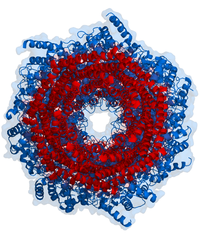
Photo from wikipedia
In the scope of targeted protein degradation (TPD), proteolysis-targeting chimeras (PROTACs), leveraging the ubiquitin-proteasome system, have been extensively studied. However, they are limited to the degradation of soluble and membrane… Click to show full abstract
In the scope of targeted protein degradation (TPD), proteolysis-targeting chimeras (PROTACs), leveraging the ubiquitin-proteasome system, have been extensively studied. However, they are limited to the degradation of soluble and membrane proteins, excluding the aggregated and extracellular proteins and dysfunctional organelles. As an alternative protein degradation pathway, lysosomes serve as a feasible tool for accessing these untouched proteins and/or organelles by proteosomes. Here, we focus on reviewing the emerging lysosome-mediated TPD, such as AUTAC, ATTEC, AUTOTAC, LYTAC, and MoDE-A. Intracellular targets, such as soluble and aggregated proteins and organelles, can be degraded via the autophagy-lysosome pathway. Extracellular targets, such as membrane proteins, and secreted extracellular proteins can be degraded via the endosome-lysosome pathway. In addition, we summarize the mechanism and regulation of autophagy, available methods and assays for monitoring the autophagy process, and the recently developed chemical probes for perturbing the autophagy pathways.
Journal Title: Biochemistry
Year Published: 2022
Link to full text (if available)
Share on Social Media: Sign Up to like & get
recommendations!